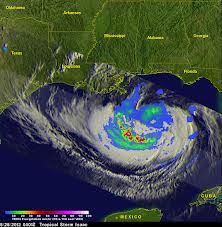Energy Prices Withstand Hurricane Isaac Threat
 The oil and natural gas markets have become less vulnerable to hurricanes as a boom in onshore shale production redraws the North American energy map.
The oil and natural gas markets have become less vulnerable to hurricanes as a boom in onshore shale production redraws the North American energy map.Crude oil and natural gas prices were choppy on Tuesday even as hurricane Isaac threatened to tear through the web of production platforms, pipelines and import terminals along the Louisiana coast on Wednesday.
The tepid market reaction in part reflected the Gulf of Mexico’s declining share of US hydrocarbons output as a result of an inland drilling boom of so-called shale deposit that has lifted total US crude output to a 14-year high.
North Dakota, about 1,600 miles north from the gulf coast, is leading the renaissance of the US oil industry, with output up a sevenfold since 2005.
Offshore wells in the Gulf now account for just 20 per cent of the country’s oil production, the lowest in 14 years, according to the US energy department. The region’s share of gas output has plunged even more, to 7 per cent of the US total.
When hurricane Ivan hit the Gulf in September 2004, the offshore region accounted for nearly 27 per cent of the country’s oil and 21 per cent of gas. The share was roughly similar a year later when devastating hurricanes Katrina and Rita arrived.
“A lot of rebalancing has gone on between offshore and onshore on the oil and gas production sides,” said Vikas Dwivedi, a Houston-based energy strategist at Macquarie.
He said the reality now was that “most storms are bearish events” as energy consumption briefly dips amid lower temperatures and heavy rain.
Brent crude, the global benchmark, fell 16 cents to $112.10 per barrel at midday Tuesday. Brent has fallen roughly 2.5 per cent since a meteorologist last week warned that hurricane Isaac was heading toward the Gulf of Mexico.
The region nonetheless remains critical to global energy markets because of its important role in the supply of fuels such as petrol and diesel. Coastal refineries in states such as Texas and Louisiana now account for 43 per cent of the country’s operable capacity, up from 41 per cent in 2004.
Exports of refined oil products from the gulf coast have doubled since 2008 and trebled since 2005 as customers from Mexico to Europe mop up excess supplies.
“The US is a lot more important as a product exporter than it used to be,” said Michael Wittner, commodity analyst at Société Générale in New York.
Refiners including Valero Energy, Phillips 66, and Marathon Petroleum were closing or slowing down operating rates in Louisiana plants ahead of the storm.
The National Hurricane Center said Isaac had intensified into a hurricane from a tropical storm on Tuesday and warned of storm surges six to 12 feet high in Mississippi and southeastern Louisiana.
The Bureau of Safety and Environmental Enforcement said 93 per cent of oil production and 67 per cent of gas production had been shut down in the Gulf of Mexico as workers evacuated platforms.
You can return to the main Market News page, or press the Back button on your browser.

